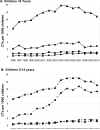The use of computed tomography in pediatrics and the associated radiation exposure and estimated cancer risk
- PMID: 23754213
- PMCID: PMC3936795
- DOI: 10.1001/jamapediatrics.2013.311
The use of computed tomography in pediatrics and the associated radiation exposure and estimated cancer risk
Abstract
Importance: Increased use of computed tomography (CT) in pediatrics raises concerns about cancer risk from exposure to ionizing radiation.
Objectives: To quantify trends in the use of CT in pediatrics and the associated radiation exposure and cancer risk.
Design: Retrospective observational study.
Setting: Seven US health care systems.
Participants: The use of CT was evaluated for children younger than 15 years of age from 1996 to 2010, including 4 857 736 child-years of observation. Radiation doses were calculated for 744 CT scans performed between 2001 and 2011.
Main outcomes and measures: Rates of CT use, organ and effective doses, and projected lifetime attributable risks of cancer. RESULTS The use of CT doubled for children younger than 5 years of age and tripled for children 5 to 14 years of age between 1996 and 2005, remained stable between 2006 and 2007, and then began to decline. Effective doses varied from 0.03 to 69.2 mSv per scan. An effective dose of 20 mSv or higher was delivered by 14% to 25% of abdomen/pelvis scans, 6% to 14% of spine scans, and 3% to 8% of chest scans. Projected lifetime attributable risks of solid cancer were higher for younger patients and girls than for older patients and boys, and they were also higher for patients who underwent CT scans of the abdomen/pelvis or spine than for patients who underwent other types of CT scans. For girls, a radiation-induced solid cancer is projected to result from every 300 to 390 abdomen/pelvis scans, 330 to 480 chest scans, and 270 to 800 spine scans, depending on age. The risk of leukemia was highest from head scans for children younger than 5 years of age at a rate of 1.9 cases per 10 000 CT scans. Nationally, 4 million pediatric CT scans of the head, abdomen/pelvis, chest, or spine performed each year are projected to cause 4870 future cancers. Reducing the highest 25% of doses to the median might prevent 43% of these cancers.
Conclusions and relevance: The increased use of CT in pediatrics, combined with the wide variability in radiation doses, has resulted in many children receiving a high-dose examination. Dose-reduction strategies targeted to the highest quartile of doses could dramatically reduce the number of radiation-induced cancers.
Figures


Comment in
-
The harm in looking.JAMA Pediatr. 2013 Aug 1;167(8):693-5. doi: 10.1001/jamapediatrics.2013.356. JAMA Pediatr. 2013. PMID: 23753832 No abstract available.
-
Image gently: child-sizing radiation dose for children.JAMA Pediatr. 2013 Nov;167(11):1083. doi: 10.1001/jamapediatrics.2013.3180. JAMA Pediatr. 2013. PMID: 24190019 No abstract available.
-
[Dose reduction could reduce the number of new cancer cases].Rofo. 2013 Nov;185(11):1034, 1036. Rofo. 2013. PMID: 24308055 German. No abstract available.
-
Measure radiation exposure and sensitivity.JAMA Pediatr. 2014 Feb;168(2):187-8. doi: 10.1001/jamapediatrics.2013.4662. JAMA Pediatr. 2014. PMID: 24492869 No abstract available.
References
-
- Brenner DJ, Hall EJ. Computed tomography--an increasing source of radiation exposure. N Engl J Med. 2007 Nov 29;357(22):2277–2284. - PubMed
-
- Broder J, Fordham LA, Warshauer DM. Increasing utilization of computed tomography in the pediatric emergency department, 2000-2006. Emerg Radiol. 2007 Sep;14(4):227–232. - PubMed
-
- Mettler FA, Jr., Bhargavan M, Faulkner K, et al. Radiologic and nuclear medicine studies in the United States and worldwide: frequency, radiation dose, and comparison with other radiation sources--1950-2007. Radiology. 2009 Nov;253(2):520–531. - PubMed
Publication types
MeSH terms
Grants and funding
LinkOut - more resources
Full Text Sources
Other Literature Sources
Medical

